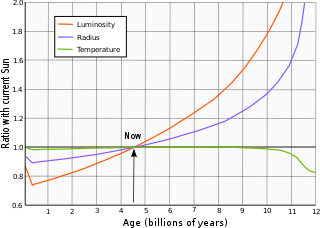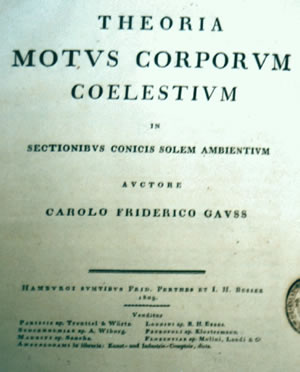
The astronomical unit is a unit of length, roughly the distance from Earth to the Sun and approximately equal to 150 million kilometres or 8.3 light-minutes. The actual distance from Earth to the Sun varies by about 3% as Earth orbits the Sun, from a maximum (aphelion) to a minimum (perihelion) and back again once each year. The astronomical unit was originally conceived as the average of Earth's aphelion and perihelion; however, since 2012 it has been defined as exactly 149597870700 m.
A day is the time period of a full rotation of the Earth with respect to the Sun. On average, this is 24 hours, 1440 minutes, or 86,400 seconds. In everyday life, the word "day" often refers to a solar day, which is the length between two solar noons or times the Sun reaches the highest point. The word "day" may also refer to daytime, a time period when the location receives direct and indirect sunlight. On Earth, as a location passes through its day, it experiences morning, noon, afternoon, evening, and night. The effect of a day is vital to many life processes, which is called the circadian rhythm.

In precise timekeeping, ΔT is a measure of the cumulative effect of the departure of the Earth's rotation period from the fixed-length day of International Atomic Time. Formally, ΔT is the time difference ΔT = TT − UT between Universal Time and Terrestrial Time. The value of ΔT for the start of 1902 was approximately zero; for 2002 it was about 64 seconds. So Earth's rotations over that century took about 64 seconds longer than would be required for days of atomic time. As well as this long-term drift in the length of the day there are short-term fluctuations in the length of day which are dealt with separately.
The term ephemeris time can in principle refer to time in association with any ephemeris. In practice it has been used more specifically to refer to:
- a former standard astronomical time scale adopted in 1952 by the IAU, and superseded during the 1970s. This time scale was proposed in 1948, to overcome the disadvantages of irregularly fluctuating mean solar time. The intent was to define a uniform time based on Newtonian theory. Ephemeris time was a first application of the concept of a dynamical time scale, in which the time and time scale are defined implicitly, inferred from the observed position of an astronomical object via the dynamical theory of its motion.
- a modern relativistic coordinate time scale, implemented by the JPL ephemeris time argument Teph, in a series of numerically integrated Development Ephemerides. Among them is the DE405 ephemeris in widespread current use. The time scale represented by Teph is closely related to, but distinct from, the TCB time scale currently adopted as a standard by the IAU.

A year is the orbital period of a planetary body, for example, the Earth, moving in its orbit around the Sun. Due to the Earth's axial tilt, the course of a year sees the passing of the seasons, marked by change in weather, the hours of daylight, and, consequently, vegetation and soil fertility. In temperate and subpolar regions around the planet, four seasons are generally recognized: spring, summer, autumn and winter. In tropical and subtropical regions, several geographical sectors do not present defined seasons; but in the seasonal tropics, the annual wet and dry seasons are recognized and tracked.

The gravitational constant, denoted by the capital letter G, is an empirical physical constant involved in the calculation of gravitational effects in Sir Isaac Newton's law of universal gravitation and in Albert Einstein's theory of general relativity.

A time standard is a specification for measuring time: either the rate at which time passes or points in time or both. In modern times, several time specifications have been officially recognized as standards, where formerly they were matters of custom and practice. An example of a kind of time standard can be a time scale, specifying a method for measuring divisions of time. A standard for civil time can specify both time intervals and time-of-day.

Sidereal time is a timekeeping system that astronomers use to locate celestial objects. Using sidereal time, it is possible to easily point a telescope to the proper coordinates in the night sky. Sidereal time is a "time scale that is based on Earth's rate of rotation measured relative to the fixed stars", or more correctly, relative to the March equinox.
A sidereal year, also called a sidereal orbital period, is the time that Earth or another planetary body takes to orbit the Sun once with respect to the fixed stars.

The orbital period is the amount of time a given astronomical object takes to complete one orbit around another object. In astronomy, it usually applies to planets or asteroids orbiting the Sun, moons orbiting planets, exoplanets orbiting other stars, or binary stars. It may also refer to the time it takes a satellite orbiting a planet or moon to complete one orbit.

The solar mass (M☉) is a standard unit of mass in astronomy, equal to approximately 2×1030 kg. It is often used to indicate the masses of other stars, as well as stellar clusters, nebulae, galaxies and black holes. It is approximately equal to the mass of the Sun. This equates to about two nonillion (short scale), two quintillion (long scale) kilograms or 2000 quettagrams:

The solar luminosity (L☉), is a unit of radiant flux conventionally used by astronomers to measure the luminosity of stars, galaxies and other celestial objects in terms of the output of the Sun.

The Gaussian gravitational constant is a parameter used in the orbital mechanics of the Solar System. It relates the orbital period to the orbit's semi-major axis and the mass of the orbiting body in Solar masses.
The astronomical system of units, formerly called the IAU (1976) System of Astronomical Constants, is a system of measurement developed for use in astronomy. It was adopted by the International Astronomical Union (IAU) in 1976 via Resolution No. 1, and has been significantly updated in 1994 and 2009.
An astronomical constant is any of several physical constants used in astronomy. Formal sets of constants, along with recommended values, have been defined by the International Astronomical Union (IAU) several times: in 1964 and in 1976. In 2009 the IAU adopted a new current set, and recognizing that new observations and techniques continuously provide better values for these constants, they decided to not fix these values, but have the Working Group on Numerical Standards continuously maintain a set of Current Best Estimates. The set of constants is widely reproduced in publications such as the Astronomical Almanac of the United States Naval Observatory and HM Nautical Almanac Office.

Earth's rotation or Earth's spin is the rotation of planet Earth around its own axis, as well as changes in the orientation of the rotation axis in space. Earth rotates eastward, in prograde motion. As viewed from the northern polar star Polaris, Earth turns counterclockwise.
In astronomy, planetary mass is a measure of the mass of a planet-like astronomical object. Within the Solar System, planets are usually measured in the astronomical system of units, where the unit of mass is the solar mass (M☉), the mass of the Sun. In the study of extrasolar planets, the unit of measure is typically the mass of Jupiter (MJ) for large gas giant planets, and the mass of Earth (MEarth) for smaller rocky terrestrial planets.
A tropical year or solar year is the time that the Sun takes to return to the same position in the sky of a celestial body of the Solar System such as the Earth, completing a full cycle of seasons; for example, the time from vernal equinox to vernal equinox, or from summer solstice to summer solstice. It is the type of year used by tropical solar calendars. The solar year is one type of astronomical year and particular orbital period. Another type is the sidereal year, which is the time it takes Earth to complete one full orbit around the Sun as measured with respect to the fixed stars, resulting in a duration of 20 minutes longer than the tropical year, because of the precession of the equinoxes.
This glossary of astronomy is a list of definitions of terms and concepts relevant to astronomy and cosmology, their sub-disciplines, and related fields. Astronomy is concerned with the study of celestial objects and phenomena that originate outside the atmosphere of Earth. The field of astronomy features an extensive vocabulary and a significant amount of jargon.
The International Astronomical Union at its XVIth General Assembly in Grenoble in 1976, accepted a whole new consistent set of astronomical constants recommended for reduction of astronomical observations, and for computation of ephemerides. It superseded the IAU's previous recommendations of 1964, became in effect in the Astronomical Almanac from 1984 onward, and remained in use until the introduction of the IAU (2009) System of Astronomical Constants. In 1994 the IAU recognized that the parameters became outdated, but retained the 1976 set for sake of continuity, but also recommended to start maintaining a set of "current best estimates".











